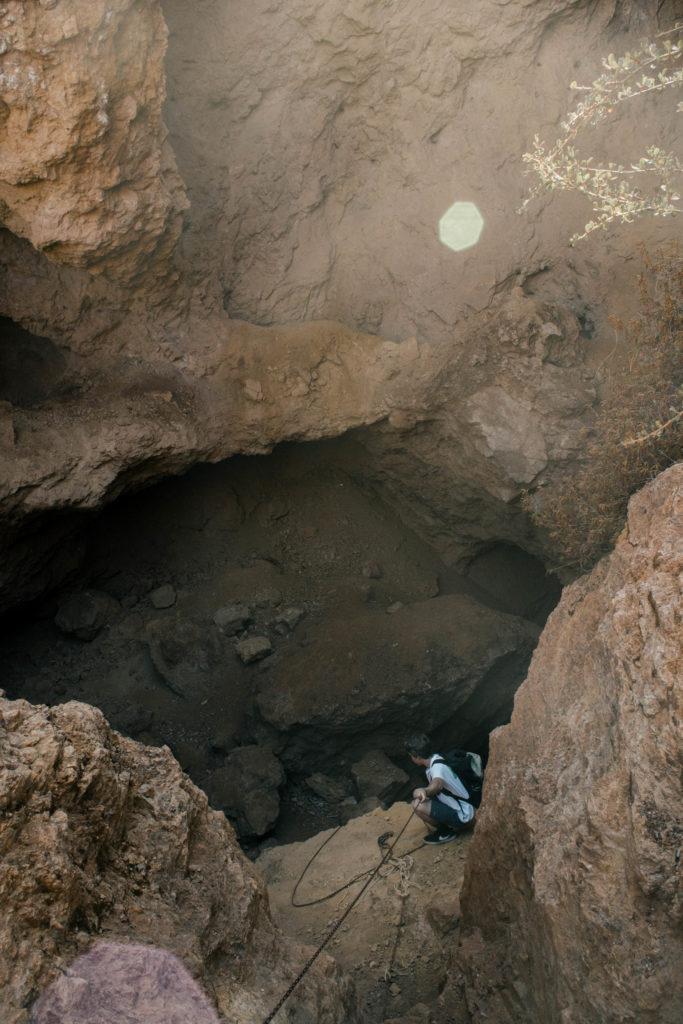There is a hiking trail nestled in the hills of San Luis Obispo County’s Los Padres National Forest, unique to most other scenic hikes that populate California’s Central Coast.
The Rinconada Trail, located approximately two miles south of Santa Margarita Lake, sits on a mountainside scarred by a mercury mine that ceased function in the 1960s. With remnants of the operation still present dotting the mountainside with open mine shafts, crumbling concrete foundations, and rusted-over machinery structures, the presence of these relics makes for a historic hiking experience.

The hike to the mine is roughly a quarter mile in length down a wide, well maintained trail that begins at the west end of the Rindonada Trailhead parking lot. At the first fork in the trail, one must veer left and continue up the hill to make it to the main Rinconada mine structure area.
As one makes their way up the trail they pass the first opening to the mine on their left hand side, roughly 50 feet from the main mining structure. Easily overlooked, the entrance takes the form of a small space between two rocks that leads to a narrow bat vent only accessible by crawling head first on your hands and knees.

The main mine area on the mountain contains the ruins of a two story steel formation, called a retort, which processed the mined mercury in the operation’s hay day. It is now caked in hundreds of layers of spray paint sitting on a decaying slab of concrete littered with beer cans and brass bullet casings. Quotes like “free your mind,†along with other paintings, are scribbled on the industrial steel skeleton of the once-booming mining operation. The scene is a hodgepodge of color, skill, and lack thereof.
“There was a huge clean up about 15 years ago, it took place all around there, it had high levels of mercury in that area, even some liquid mercury laying around, so it was pretty dangerous, that was all taken care of right there in that mine processing site,†said Kevin Cooper, a retired Los Padres National Forest biologist.

In regards to safety, there are indications of the county’s prior attempts (made in vain) to ensure a safer trail. Signs are present that once bore warning of bodily danger and instructions to steer clear of the open mine shaft, but these same signs are now peppered with bullet holes, and adorned with florescent gibberish.
There is also remanence of a steel cable guardrail originally designed to prevent entrance to the mine shaft. The steel cables were reappropriated by previous trespassers to now assist in the scaling of the slope, making way to the mine’s portal.Â

Though highly inadvisable, to enter the mine one would have a choice of either repelling in through the open portal at the top of the mountain, or army-crawling through the previously mentioned bat vent located further down the mountain. For those lacking substantial repelling equipment, there is a previously installed rope of highly questionable integrity dangling down into the shaft that is just long enough to reach the equally questionable dilapidated ladder which assists in bringing one the rest of the way down into the mercury mine’s portal.Â


Once in the mine, there are spray painted defacements of arrows on the rock walls directing hikers to who-knows-where, the presence of bats, and other obvious extreme dangers associated with the mine. The further one descends into the depths, the more the adventure begins to resemble a life-or-death game of shoots and ladders, with the presence of spontaneous pit falls, partial cave-ins and seemingly bottomless ravines.

“The mine shaft itself can collapse, you can fall way down in there, there’s constant rock falling down from high elevations, there’s poisonous gasses that get trapped in some of the tunnels in there,†Cooper said. “If you actually get inside of it and walk around there’s shafts that have been covered with plywood that go vertically straight down, and the plywood’s really old, that breaks through and you’re going to plummet to however deep that shaft is. There’s just a million reasons to not go into that mine, it’s super dangerous.â€

Overall, if one stays on the trail and steers clear from the open mine portal, the Rinconada hike is comparable in safety to virtually any other traditional hike, with a lot to offer, from scenic views to historic relics of the past. The trail’s short nature, and presence of adequate shade, makes for a light and easy hike doable year round.








Nicely written, sounds like a hiking adventure. You put major effort into presenting the story. Liked the photos as well. Couple of suggestions: “heyday” and “remnants”
You must be insane to play up this site as an adventure. I assisted a geologist in surveying the interior “glory hole” in 1970. This was about 20 years after the last attempt to operate the mine.
There was a sight that chilled me to the bone in the walls of that cave. There were dozens of exposed drill holes (unused) with fuses sticking out of them. Now maybe it was somebody’s practical joke. But at the time, all I could imagine was a stick of very old dynamite with nitroglycerin dripping out of it in every hole with a fuse. All it would take to set off this very sensitive explosive would be for some fool to pull on one of those fuses out of curiosity (or an earthquake).
Now that you’ve opened up pandora’s box, I think you should take the responsibility of following up on this potential deadly hazard. One other thing we found in the metal debris strewn about the entrance were numerous diamond back rattlesnakes enjoying the warmth of the sun on the sheets. of metal.
In my opinion, the owners should have blown up the cave decades ago. The only dangers remaining would be mercury poisoning and snake bites.
Comments are closed.